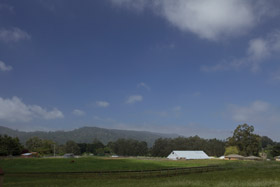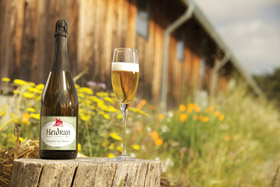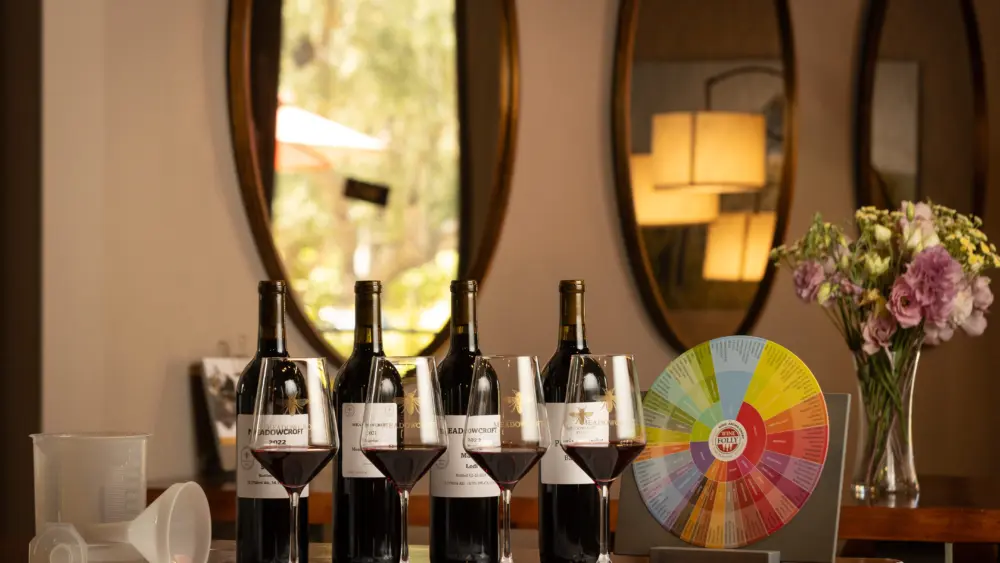Point Reyes Station, CA 94956
(415) 663-9122
www.heidrunmeadery.com
Hours: By reservation only on Mondays, Tuesdays, Thursdays, Fridays and Saturdays between 10:00 a.m. and 4:00 p.m. or by special arrangement.
Fees: $15 for estate tour and tasting, $10 for tasting flight (no tour), no fee for by-the-glass
Meads currently offered: Hawaiian Lehuna Blossom, California Orange Blossom, California Sage Blossom, Madras Carrot Blossom, California Avocado Blossom, Hawaiian Macadamia Nut Blossom, Humboldt County Wildflower
Picnics: No
 Heidrun Meadery in Point Reyes casts a spell of enchantment from the moment you enter its driveway. An arch of leafy Sweetgum trees welcomes you, then the view expands into a classic West Marin pastoral scene: Industrial-scale greenhouse and tin-roofed barn in the foreground, chicken coop and weeping willow out back and a requisite bank of fog holding steady at the coast 10 miles away. About a dozen white bee boxes stand in columns next to the farm buildings. Heidrun’s estate bees fly in and out industriously, supplying their hives with nectar and pollen foraged from lavender, bee balm and other flowers on the property.
Heidrun Meadery in Point Reyes casts a spell of enchantment from the moment you enter its driveway. An arch of leafy Sweetgum trees welcomes you, then the view expands into a classic West Marin pastoral scene: Industrial-scale greenhouse and tin-roofed barn in the foreground, chicken coop and weeping willow out back and a requisite bank of fog holding steady at the coast 10 miles away. About a dozen white bee boxes stand in columns next to the farm buildings. Heidrun’s estate bees fly in and out industriously, supplying their hives with nectar and pollen foraged from lavender, bee balm and other flowers on the property.
The locale, buildings and, especially, the bees represent the next phase in a journey Heidrun’s founder, Gordon Hull, started 16 years ago in Arcata, Calif. Back then, Hull was a geologist testing out a career in beer brewing. In between brewing gigs, he decided to experiment with mead, a type of wine made from fermented honey. The thought of working with honey—what Hull calls a “beautiful substance”—attracted him, but so did the challenge: He disliked the cloying sweetness and heavily spiced nature of traditional mead and believed it was possible to make mead in a style that would be more appealing to the modern palate.
So he designed a fermentation program that had the potential of resulting in a dry, sparkling mead, then initiated that fermentation program in his pilot brewing system using a gallon of clover honey. The delicious result two months later piqued both Hull’s brewing curiosity and his entrepreneurial instincts. Putting aside his stable career as a geologist, he launched Heidrun Meadery in 1997 and channeled his energy into building a business and fine-tuning his innovative style of mead. Today, Hull draws on techniques from brewing and winemaking, including the traditional French méthode champenoise, to craft meads that are dry, effervescent and floral in both flavor and aroma—no spice or added sugar necessary.
“Bees make honey from the nectar of flowers and, in a sense, our objective as meadmakers is to use fermentation to convert that honey back into nectar,” explains Hull. “Every variety of honey has a unique flavor that’s linked to the flower nectar from which it was derived. Our meads seek to reveal that unique expression of nature.”
Live and learn
Hull purchased his Point Reyes property in 2008 and, after extensive renovations, opened for tours and tastings in 2013. Heidrun’s new home beautifully showcases every aspect of mead production—from a bee collecting nectar and a beekeeper harvesting honey to the meadmaker overseeing fermentation and visitors tasting the end product. Tours last about an hour and can be customized to focus on any or all of these aspects. With a staff that includes a beekeeper, horticulturalist, sales director and Hull, Heidrun offers a wealth of knowledge.
My visit began at the greenhouse (a.k.a. tasting room) with a glass of deliciously crisp Lehua Blossom mead, made with honey sourced from the Big Island of Hawaii. Hull recommends all his meads be served ice cold to preserve the floral notes, and in a champagne flute to heighten aromatics and effervescence. Some mead varieties, like the California Orange Blossom, which I sampled next, taste sweeter on the palate than others. According to Hull, sometimes this is because our mouths are fooled by the suggested sweetness of the honey. Other times, certain honeys don’t fully break down during the fermentation process, and rather than try to eliminate the residual sugars, Hull celebrates them: The variability in sweetness across his mead varietals adds another dimension to food parings. The brut (dry) quality of the Lehua Blossom contrasts perfectly with sumptuous oysters, for example, while the slightly sweeter Orange Blossom offsets the spice in Thai food.
Conversation about fermentation segues to the next part of the tour, which involves watching Hull in action in the restored barn. Walking in, I spot 50-gallon drums stacked next to white, food-grade buckets of varying sizes, all containing multiple varieties of honey harvested from disparate locations and in different years. Honey is a non-perishable product, which gives Hull flexibility to purchase or harvest when it’s available, yet still make mead on his own timeline. By the same token, it precludes a vintage stamp on the bottle.
Further into the barn is the hodge-podge of equipment Hull uses throughout the meadmaking process: a long metal pole that liquefies the honey, large stainless steel kettles and fermenters, bottling equipment and an automated riddling rack that stretches three-quarters to the barn’s ceiling. Hull developed his proprietary process through trial and error, borrowing techniques from brewing and winemaking but also creating new techniques along the way. He’s rehabilitated or customized much of his equipment, and his well-earned tinkerer’s pride shows through in a delightful way. The sweetest part of the barn tour? Sampling a fingerful of warm, orange blossom honey straight from the drum.
Bee happy
Leaving the barn, visitors have the option of learning more about Heidrun’s beekeeping endeavors or finding a spot under the weeping willow to finish tasting other meads in Heidrun’s repertoire. I enjoyed Sage Blossom, with notes of pear and jasmine. Madras Carrot Blossom—made with honey purchased from an Oregon beekeeper who pollinates carrot crops grown for seed—intrigues with a flavor profile and texture resembling Belgian Saisons beer; it’s herbal, almost hoppy; it pairs well with savory foods. Sipping Avocado Blossom, I listened as Hull explained the unchartered territory he faced when working with that honey for the first time.
“Meadmakers caution against the use of avocado blossom honey because of its pungency,” says Hull. “But in the case of our sparkling dry meads, that stronger flavor becomes an asset. We get a refreshing, brut mead with a hop-like bite at the finish—much like a Czech pilsner experience but without the gluten.” Perhaps not surprisingly, Avocado Blossom mead pairs well with Mexican food, grilled sausages and German fare.
Hull says his mead reflects the geography and soil in which a flower grows, the practices of the beekeeper and the production techniques of the meadmaker. While soil can be tested and meadmakers interviewed, much goes unexplained when it comes to the role bees play in influencing a mead’s terroir.
“The bee colony is an incredibly complex organism, impossible even for the most expert beekeeper to fully understand,” says Hull. “Our goal at Heidrun is to reveal just one facet of that complexity—the relationship between the flower and the bee and the mead we make. Visitors come here to enjoy our sparkling meads. but they always leave with a deeper appreciation of the essential role honey bees play in our ecology.”




